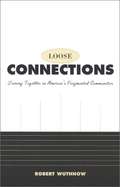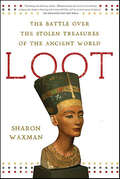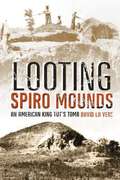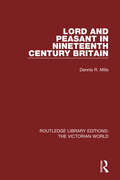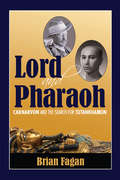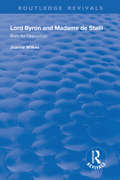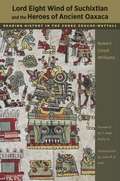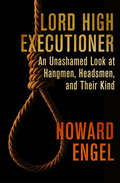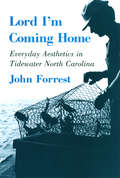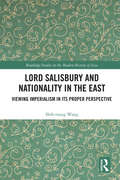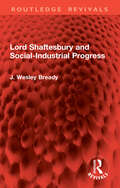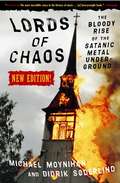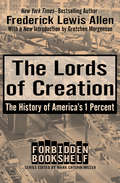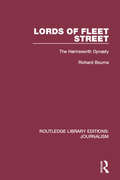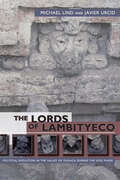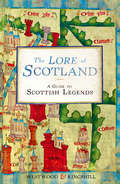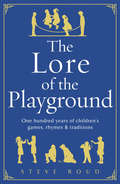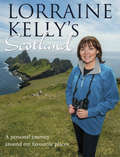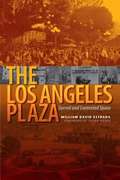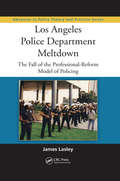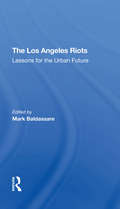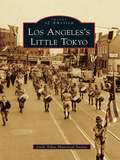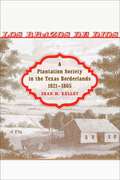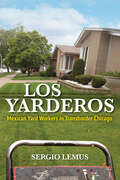- Table View
- List View
Loose Connections: Joining Together In America's Fragmented Communities
by Robert WuthnowIt has become common to lament Americans' tendency to pursue individual interests apart from any institutional association. But to those who charge that Americans are at home watching television rather than getting involved in their communities, Robert Wuthnow answers that while certain kinds of civic engagement may be declining, innovative new forms are taking their place. <p><p> Acknowledging that there has been a significant change in group affiliations--away from traditional civic organizations--Wuthnow shows that there has been a corresponding movement toward affiliations that respond to individual needs and collective concerns. Many Americans are finding new and original ways to help one another through short-term task-oriented networks. Some are combining occupational skills with community interests in nonprofit and voluntary associations. Others use communication technologies, such as the World Wide Web, to connect with like-minded people in distant locations. And people are joining less formal associations, such as support groups and lobbying efforts, within their home communities. <p> People are still connected, but because of the realities of daily life, they form "loose connections." These more fluid groups are better suited to dealing with today's needs than the fraternal orders and ladies' auxiliaries of the past. Wuthnow looks at the challenges that must be faced if these innovative forms of civic involvement are to flourish, and calls for resources to be made available to strengthen the more constructive and civic dimensions of these organizations. This book helps us to understand and encourage the community spirit of today.
Loot: The Battle Over the Stolen Treasures of the Ancient World
by Sharon WaxmanA journey across four continents to the heart of the conflict over who should own the great works of ancient artWhy are the Elgin Marbles in London and not on the Acropolis? Why do there seem to be as many mummies in France as there are in Egypt? Why are so many Etruscan masterworks in America? For the past two centuries, the West has been plundering the treasures of the ancient world to fill its great museums, but in recent years, the countries where ancient civilizations originated have begun to push back, taking museums to court, prosecuting curators, and threatening to force the return of these priceless objects.Where do these treasures rightly belong? Sharon Waxman, a former culture reporter for The New York Times and a longtime foreign correspondent, brings us inside this high-stakes conflict, examining the implications for the preservation of the objects themselves and for how we understand our shared cultural heritage. Her journey takes readers from the great cities of Europe and America to Egypt, Turkey, Greece, and Italy, as these countries face down the Louvre, the Metropolitan Museum, the British Museum, and the J. Paul Getty Museum. She also introduces a cast of determined and implacable characters whose battles may strip these museums of some of their most cherished treasures.For readers who are fascinated by antiquity, who love to frequent museums, and who believe in the value of cultural exchange, Loot opens a new window on an enduring conflict.
Looting Spiro Mounds: An American King Tut's Tomb
by David La VereVere (history, U. of North Carolina, Wilmington) recounts the looting of the Spiro Mounds in eastern Oklahoma in 1935, which contained a large amount of pre-Columbian art. He describes the founding and settlement of the area from 800 A.D., the culture and life of the people, and the decline of the chiefdom by 1450 A.D. These chapters are interwoven with the story of how the Pocola Mining Company found the Mounds in the 1930s and looted the objects, the fight with them by U. of Oklahoma's anthropologist Forrest Clements over who had property rights, Works Progress Administration excavation, and past and present theories about Spiro and its people. Annotation ©2007 Book News, Inc., Portland, OR (booknews.com)
Lord and Peasant in Nineteenth Century Britain (Routledge Library Editions: The Victorian World #34)
by Dennis R. MillsFirst published in 1980, this book looks at the social structure of 18th and 19th century rural Britain. It is particularly concerned with the relationship of landlord and peasant in the rural village and examines the open-closed model of English rural social structure in great depth. In doing so, it explores the ways in which the estate system influenced urban development and how the peasant system facilitated the industrialisation of many villages. This book will be of particular interest to students of Victorian and social history, industrialisation and urbanisation.
Lord and Pharaoh: Carnarvon and the Search for Tutankhamun
by Brian FaganBoth born to power and wealth, and raised by courtiers, they lived lives of aristocrats and landowners, in poor health and with uncertain futures. Though they lived over 3000 years apart, the lives of Egyptian King Tutankhamun and the fifth Lord Carnarvon share many parallels, not the least of which was Carnarvon’s sponsorship of the team that found the pharaoh’s tomb in the Valley of the Kings. Brian Fagan’s narrative expertly weaves these two lives together, showing similarities and differences between these two powerful men. -Both figures are placed in their historical context, showing the political and social machinations of 18th Dynasty Egypt and 20th century archaeological exploration in Egypt.-Grounded in historical and archaeological research, the two figures are made to come alive as real people.-An Afterword by the author shows archaeologists how to tell research stories that are accessible to a wider audience.
Lord Byron and Madame de Staël: Born for Opposition (Routledge Revivals)
by Joanne WilkesPublished in 1999. Lord Byron and Madam de Stael made a great impression on Europe in the throes of the Napoleonic Wars, through their personalities, the versions of themselves which they projected through their works, and their literary engagement with contemporary life. However, the strong links between them have never before been explored in detail. This pioneering study looks at their personal relations, from their verbal sparring in Regency society, through the friendship which developed in Switzerland after Byron left England in 1816, to Byron’s tributes to Mme de Stael after her death. It concentrates on their literary links, both direct responses to each other’s works, and the copious evidence of shared concerns. The study deals with their treatment of gender, their grappling with the possibilities for heroic endeavour, their engagement with the social and political situations of Britain, France and Italy, and their conceptions of the role of the writer. Although Byron will need no introduction, Mme de Stael’s standing as a French romantic writer of the first rank is made plain by the strong impact of her writings on the English Poet.
Lord Byron and Scandalous Celebrity
by Clara TuiteThe Regency period in general, and the aristocrat-poet Lord Byron in particular, were notorious for scandal, but the historical circumstances of this phenomenon have yet to be properly analysed. Lord Byron and Scandalous Celebrity explores Byron's celebrity persona in the literary, social, political and historical contexts of Regency Britain and post-Napoleonic Europe that produced it. Clara Tuite argues that the Byronic enigma that so compelled contemporary audiences - and provoked such controversy with its spectacular Romantic Satanism - can be understood by means of 'scandalous celebrity', a new form of ambivalent fame that mediates between notoriety and traditional forms of heroic renown. Examining Byron alongside contemporary figures including Caroline Lamb, Stendhal, Napoleon Bonaparte and Lord Castlereagh, Tuite illuminates the central role played by Byron in the literary, political and sexual scandals that mark the Regency as a vital period of social transition and emergent celebrity culture.
Lord Eight Wind of Suchixtlan and the Heroes of Ancient Oaxaca
by Robert Lloyd WilliamsIn the pre-Hispanic Mesoamerican world, histories and collections of ritual knowledge were often presented in the form of painted and folded books now known as codices, and the knowledge itself was encoded into pictographs. Eight codices have survived from the Mixtec peoples of ancient Oaxaca, Mexico; a part of one of them, the Codex Zouche-Nuttall, is the subject of this book. As a group, the Mixtec codices contain the longest detailed histories and royal genealogies known for any indigenous people in the western hemisphere. The Codex Zouche-Nuttall offers a unique window into how the Mixtecs themselves viewed their social and political cosmos without the bias of western European interpretation. At the same time, however, the complex calendrical information recorded in the Zouche-Nuttall has made it resistant to historical, chronological analysis, thereby rendering its narrative obscure. In this pathfinding work, Robert Lloyd Williams presents a methodology for reading the Codex Zouche-Nuttall that unlocks its essentially linear historical chronology. Recognizing that the codex is a combination of history in the European sense and the timelessness of myth in the Native American sense, he brings to vivid life the history of Lord Eight Wind of Suchixtlan (AD 935–1027), a ruler with the attributes of both man and deity, as well as other heroic Oaxacan figures. Williams also provides context for the history of Lord Eight Wind through essays dealing with Mixtec ceremonial rites and social structure, drawn from information in five surviving Mixtec codices.
Lord High Executioner: An Unashamed Look at Hangmen, Headsmen, and Their Kind
by Howard EngelA grisly tour of hangings, electrocutions, beheadings—and other state-sanctioned deaths that are part of the long history of the death penalty. In Lord High Executioner, award-winning writer Howard Engel traces the traditions of capital punishment from medieval England and early Canada to the present-day United States. Throughout &“civilized&” history, executioners employed on behalf of the kingdom, republic, or dictatorship have beheaded, chopped, stabbed, choked, gassed, electrocuted, or beaten criminals to death—and Engel doesn&’t shy away from the gritty details of the executioner&’s lifestyle, focusing on the paragons, buffoons, and sadists of the dark profession. Packed with all-too-true stories, from hapless hangings to butchered beheadings, this historically accurate look at the executioner&’s gruesome work makes for a thoroughly gripping read.
Lord I'm Coming Home: Everyday Aesthetics in Tidewater North Carolina (The Anthropology of Contemporary Issues)
by John ForrestLord I'm Coming Home focuses on a small, white, rural fishing community on the southern reaches of the Great Dismal Swamp in North Carolina. By means of a new kind of anthropological fieldwork, John Forrest seeks to document the entire aesthetic experience of a group of people, showing the aesthetic to be an "everyday experience and not some rarefied and pure behavior reserved for an artistic elite."The opening chapter of the book is a vivid fictional narrative of a typical day in "Tidewater," presented from the perspective of one fisherman. In the following two chapters the author sets forth the philosophical and anthropological foundations of his book, paying particular attention to problems of defining "aesthetic," to methodological concerns, and to the natural landscape of his field site. Reviewing his own experience as both participant and observer, he then describes in scrupulous detail the aesthetic forms in four areas of Tidewater life: home, work, church, and leisure. People use these forms, Forrest shows, to establish personal and group identities, facilitate certain kinds of interactions while inhibiting others, and cue appropriate behavior. His concluding chapter deals with the different life cycles of men and women, insider-outsider relations, secular and sacred domains, the image and metaphor of "home," and the essential role that aesthetics plays in these spheres. The first ethnography to evoke the full aesthetic life of a community, Lord I'm Coming Home will be important reading not only for anthropologists but also for scholars and students in the fields of American studies, art, folklore, and sociology.
Lord Salisbury and Nationality in the East: Viewing Imperialism in its Proper Perspective (Routledge Studies in the Modern History of Asia)
by Shih-tsung WangThis study explains how Salisbury viewed cultural conflicts between the East and the West, how he treated Oriental nationality and nationalist aspirations in British dominions in the East, and how he directed British policy in the Eastern world in a time when the Western Powers were plunging into a struggle for spheres of predominance. In pursuit of British imperial interests, Salisbury was outwardly determined, but acutely aware of the inherent moral conflicts. He understood that the expansion of Europe was inevitable, but, taking into account the rights and feelings of the Eastern nations, he endeavoured to reduce his country’s impact on the peoples subjected to British control. Hence his preference for the generally peaceful invasion effected by informal empire. Following an introductory discussion on Salisbury’s ideas and policy, particularly in the light of his treatment of nationality, this research investigates his record in India, Turkey, Egypt, and China to argue for a strikingly sympathetic attitude in his dealings with Eastern nationalities. While it is a truism to say that British imperialism was coloured by Christian beliefs and liberal principles, it has not yet been appreciated how far Salisbury succeeded in reconciling the moral and practical demands of Western civilization upon itself with the requirements of power.
Lord Shaftesbury and Social-Industrial Progress (Routledge Revivals)
by J. Wesley BreadyOriginally published in 1926, this volume is much more than a biography of an outstanding politician, social reformer and philosopher. It provides an analysis of the history of social conditions in England during the nineteenth century, as well as a discussion of the development of social affairs and the inertia of political psychology. The role that faith and religion played in motivating Lord Shaftesbury’s desire for social reform is also discussed as is the ways in which he and John Wesley transformed the social and ethical ideas of England to enshrine in law many of the working conditions that we take for granted today such as defined hours of work and rest periods.
Lords of Chaos
by Didrik Soderlind Michael Moynihan"* * * * * *! The most incredible story in the history of music ... a heavyweight book."--Kerrang!"An unusual combination of true crime journalism, rock and roll reporting and underground obsessiveness, Lords of Chaos turns into one of the more fascinating reads in a long time."--Denver PostA narrative feature film based on this award-winning book has just gone into production.
The Lords of Creation: The History of America's 1 Percent (Forbidden Bookshelf #1)
by Mark Crispin Miller Gretchen Morgenson Frederick Lewis AllenAn acclaimed classic detailing the economic history of America in the late nineteenth and early twentieth centuries and exposing the capitalist giants who changed the worldFrederick Lewis Allen's insightful financial history of the United States--from the late 1800s through the stock market collapse of 1929--remains a seminal work on what brought on America's worst economic disaster: the Great Depression. In the decades following the Civil War, America entered an era of unprecedented corporate expansion, with ultimate financial power in the hands of a few wealthy industrialists who exploited the capitalist system for everything it was worth. The Rockefellers, Fords, Morgans, and Vanderbilts were the "lords of creation" who, along with like-minded magnates, controlled the economic destiny of the country, unrestrained by regulations or moral imperatives. Through a combination of foresight, ingenuity, ruthlessness, and greed, America's giants of industry remolded the US economy in their own preferred image. In so doing, they established their absolute power and authority, ensuring that they--and they alone--would control the means of production, transportation, energy, and commerce--thereby setting the stage for the most devastating global financial collapse in history.As Gretchen Morgenson thoughtfully states in her introduction, "It is not immediately clear why the frequency and severity of financial scandals is increasing in the United States. What is clear is that we need to understand the origins of these disasters, as well as the policies and people that bring them on. . . . While distant actions may seem unrelated to current events, rereading about the past almost always provides surprising insights into the present."The Lords of Creation, first published in the midst of the Great Depression, when the financial catastrophe was still painfully fresh, is a fascinating story of bankers, railroad tycoons, steel magnates, speculators, scoundrels, and robber barons. It is a tale of innovation and shocking exploitation--and a sobering reminder that history can indeed repeat itself.
Lords of Fleet Street: The Harmsworth Dynasty (Routledge Library Editions: Journalism #3)
by Richard BourneOriginally published in 1990. The Harmsworth family, starting with Lord Northcliffe (1865-1922) is the greatest and most influential press dynasty Britain has known. The dynasty has had by far the greatest impact on the shape of the press today of all the great press families. The Harmsworths were big, bold characters, enormously rich and with a gift for flamboyant use of their wealth. Much more important though is the way they used their influence on public opinion to steer the country’s political and social life. ‘Public opinion’ was a force that the Harmsworths harnessed before anyone else, and they quickly understood how to use it as a political tool. This book is constructed as four biographies which together make up the central story of the popular press in Britain. Their story continues to have relevance.
The Lords of Lambityeco: Political Evolution in the Valley of Oaxaca during the Xoo Phase (Mesoamerican Worlds)
by Michael Lind Javier UrcidThe Valley of Oaxaca was unified under the rule of Monte Albán until its collapse around AD 800. Using findings from John Paddock’s long-term excavations at Lambityeco from 1961 to 1976, Michael Lind and Javier Urcid examine the political and social organization of the ancient community during the Xoo Phase (Late Classic period).Focusing on change within this single archaeological period rather than between time periods, The Lords of Lambityeco traces the changing political relationships between Lambityeco and Monte Albán that led to the fall of the Zapotec state. Using detailed analysis of elite and common houses, tombs, and associated artifacts, the authors demonstrate increased political control by Monte Albán over Lambityeco prior to the abandonment of both settlements. Lambityeco is the most thoroughly researched Classic period site in the valley after Monte Albán, but only a small number of summary articles have been published about this important locale. This, in combination with Lambityeco’s status as a secondary center—one that allows for greater understanding of core and periphery dynamics in the Monte Albán state—makes The Lords of Lambityeco a welcome and significant contribution to the literature on ancient Mesoamerica.
The Lore of Scotland: A guide to Scottish legends
by Sophia Kingshill Jennifer Beatrice WestwoodScotland's rich past and varied landscape have inspired an extraordinary array of legends and beliefs, and in The Lore of Scotland Jennifer Westwood and Sophia Kingshill bring together many of the finest and most intriguing: stories of heroes and bloody feuds, tales of giants, fairies, and witches, and accounts of local customs and traditions. Their range extends right across the country, from the Borders with their haunting ballads, via Glasgow, site of St Mungo's miracles, to the fateful battlefield of Culloden, and finally to the Shetlands, home of the seal-people. More than simply retelling these stories, The Lore of Scotland explores their origins, showing how and when they arose and investigating what basis - if any - they have in historical fact. In the process, it uncovers the events that inspired Shakespeare's Macbeth, probes the claim that Mary King's Close is the most haunted street in Edinburgh, and examines the surprising truth behind the fame of the MacCrimmons, Skye's unsurpassed bagpipers. Moreover, it reveals how generations of Picts, Vikings, Celtic saints and Presbyterian reformers shaped the myriad tales that still circulate, and, from across the country, it gathers together legends of such renowned figures as Sir William Wallace, St Columba, and the great warrior Fingal. The result is a thrilling journey through Scotland's legendary past and an endlessly fascinating account of the traditions and beliefs that play such an important role in its heritage.
The Lore of the Playground: One hundred years of children's games, rhymes and traditions
by Steve RoudFrom conkers to marbles, from British Bulldog to tag, not forgetting 'one potato, two potato' and 'eeny, meeny, miny, mo', The Lore of the Playground looks at the games children have enjoyed, the rhymes they have chanted and the rituals and traditions they have observed over the past hundred years and more. Each generation, it emerges, has had its own favourites - hoops and tops in the 1930s, clapping games more recently. Some pastimes, such as skipping, have proved remarkably resilient, their complicated rules carefully handed down from one class to the next. Many are now the stuff of distant memory. And some traditions have proved to be strongly regional, loved by children in one part of the country, unknown to those elsewhere. All are brilliantly and meticulously recorded by Steve Roud, who has drawn on interviews with hundreds of people aged from 8 to 80 to create a fascinating picture of all our childhoods.
Lorraine Kelly's Scotland
by Lorraine KellyFrom childhood family day trips to Loch Lomond, to her days as TVam’s roving correspondent, Lorraine Kelly has covered the length and breadth of Scotland. But certain special places tug at her heartstrings and lure her back time and time again. Travelling to the highlands and islands and all her favourite places in between, this is Lorraine’s personal journey around her beautiful and beguiling country. Each and every stop gives rise to fascinating stories and memories along the way, from her adopted home of Dundee to the wild and remote islands of St Kilda. She revisits childhood haunts in Glasgow, indulges in a spot of whisky-tasting on the island of Islay and reveals what led her to once arrive in Edinburgh pushing a pram and wearing a pair of rollerskates. She rediscovers the joys of the natural wilderness in the Highlands, visits a dramatic Viking fire festival in Shetland and recalls the week she and her family spent hunting the Loch Ness monster . . . Beautifully illustrated with stunning original photographs, Lorraine Kelly’s Scotland is a celebration of a gloriously diverse country with a deep and rich heritage, told with all Lorraine’s characteristic warmth and humour.
The Los Angeles Plaza
by William David EstradaCity plazas worldwide are centers of cultural expression and artistic display. They are settings for everyday urban life where daily interactions, economic exchanges, and informal conversations occur, thereby creating a socially meaningful place at the core of a city. At the heart of historic Los Angeles, the Plaza represents a quintessential public space where real and imagined narratives overlap and provide as many questions as answers about the development of the city and what it means to be an Angeleno. The author, a social and cultural historian who specializes in nineteenth- and early twentieth-century Los Angeles, is well suited to explore the complex history and modern-day relevance of the Los Angeles Plaza. From its indigenous and colonial origins to the present day, Estrada explores the subject from an interdisciplinary and multiethnic perspective, delving into the pages of local newspapers, diaries and letters, and the personal memories of former and present Plaza residents, in order to examine the spatial and social dimensions of the Plaza over an extended period of time. The author contributes to the growing historiography of Los Angeles by providing a groundbreaking analysis of the original core of the city that covers a long span of time, space, and social relations. He examines the impact of change on the lives of ordinary people in a specific place, and how this change reflects the larger story of the city.
Los Angeles Police Department Meltdown: The Fall of the Professional-Reform Model of Policing
by James LasleyOnce considered among the most respected police departments in the world, the LAPD suffered a devastating fall from grace following the 1991 police officer beating of Rodney King and the Los Angeles riots stemming from the officers acquittal in 1992. Unique to the literature of policing, management, and policy studies, Los Angeles Police Departmen
The Los Angeles Riots: Lessons For The Urban Future
by Edgar W Butler Mark Baldassare David O Sears Peter A MorrisonThe Los Angeles riots in the Spring of 1992 were among the most violent and destructive events in twentieth-century urban America. This collection of original essays by leading urban experts offers the first comprehensive analysis of the unrest that took place after a jury acquitted the police officers who were accused of using excessive force in t
Los Angeles's Little Tokyo (Images of America)
by Little Tokyo Historical SocietyIn 1884, a Japanese sailor named Hamanosuke Shigeta made his way to the eastern section of downtown Los Angeles and opened Little Tokyo's first business, an American-style café. By the early 20th century, this neighborhood on the banks of the Los Angeles River had developed into a vibrant community serving the burgeoning Japanese American population of Southern California. When Japanese Americans were forcibly removed to internment camps in 1942 following the attack on Pearl Harbor and the United States' entrance into World War II, Little Tokyo was rechristened "Bronzeville" as a newly established African American enclave popular for its jazz clubs and churches. Despite the War Relocation Authority's opposition to re-establishing Little Tokyo following the war, Japanese Americans gradually restored the strong ties evident today in 21st-century Little Tokyo--a multicultural, multigenerational community that is the largest Nihonmachi (Japantown) in the United States.
Los Brazos de Dios: A Plantation Society in the Texas Borderlands, 1821--1865 (Conflicting Worlds: New Dimensions of the American Civil War)
by Sean M. KelleyHistorians have long believed that the "frontier" shaped Texas plantation society, but in this detailed examination of Texas's most important plantation region, Sean M. Kelley asserts that the dominant influence was not the frontier but the Mexican Republic. The Lower Brazos River Valley -- the only slave society to take root under Mexican sovereignty -- made replication of eastern plantation culture extremely difficult and complicated. By tracing the synthesis of cultures, races, and politics in the region, Kelley reveals a distinct variant of southern slavery -- a borderland plantation society.Kelley opens by examining the four migration streams that defined the antebellum Brazos community: Anglo-Americans and their African American slaves who constituted the first two groups to immigrate; Germans who came after the Mexican government barred immigrants from the U.S. while encouraging those from Europe; and African-born slaves brought in through Cuba who ultimately made up the largest concentration of enslaved Africans in the antebellum South. Within this multicultural milieu, Kelley shows, the disparity between Mexican law and German practices complicated southern familial relationships and master-slave interaction. Though the Mexican policy on slavery was ambiguous, alternating between toleration and condemnation, Brazos slaves perceived the Rio Grande River as the boundary between white supremacy and racial egalitarianism. As a result, thousands fled across the border, further destabilizing the Brazos plantation society. In the1850s, nonslaveholding Germans also contributed to the upheaval by expressing a sense of ethnic solidarity in politics. In an attempt to undermine Anglo efforts to draw a sharp boundary between black and white, some Germans hid runaway slaves. Ultimately, Kelley demonstrates how the Civil War brought these issues to the fore, eroding the very foundations of Brazos plantation society. With Los Brazos de Dios, Kelley offers the first examination of Texas slavery as a borderland institution and reveals the difficulty with which southern plantation society was transplanted in the West.
Los Yarderos: Mexican Yard Workers in Transborder Chicago (Latinos in Chicago and Midwest)
by Sergio LemusMigrants from the Mexican states of Zacatecas, Guanajuato, Jalisco, and Michoacán have become an important presence in Chicago and the Midwest. Many hold jobs as yarderos gardening, caring for lawns, and doing other landscaping work. Sergio Lemus explores the lives of these migrants and looks at the struggles they face as they work to make the city their home. Drawing on fieldwork in South Chicago, Lemus tells the stories of first and second-generation yarderos and discusses the historical, economic, cultural, and political ramifications they face as they acquire their working-class identity. Lemus’s compassionate portrait places them within America’s ongoing tradition as a nation of immigrants while analyzing their place within today’s transborder cultural moment. Perceptive and humane, Los Yarderos reveals how a group of Mexican immigrants navigates the crossings of the borders that divide class, color hierarchies, gender, and belonging.
